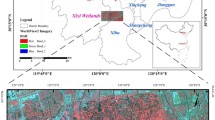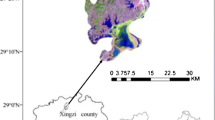Abstract
Wetland research has become a hot spot linking multiple disciplines presently. Wetland classification and mapping is the basis for wetland research. It is difficult to generate wetland data sets using traditional methods because of the low accessibility of wetlands, hence remote sensing data have become one of the primary data sources in wetland research. This paper presents a case study conducted at the core area of Honghe National Nature Reserve in the Sanjiang Plain, Northeast China. In this study, three images generated by airship, from Thematic Mapper and from SPOT 5 were selected to produce wetland maps at three different wetland landscape levels. After assessing classification accuracies of the three maps, we compared the different wetland mapping results of 11 plant communities to the airship image, 6 plant ecotypes to the TM image and 9 landscape classifications to the SPOT 5 image. We discussed the different characteristics of the hierarchical ecosystem classifications based on the spatial scales of the different images. The results indicate that spatial scales of remote sensing data have an important link to the hierarchies of wetland plant ecosystems displayed on the wetland landscape maps. The richness of wetland landscape information derived from an image closely relates to its spatial resolution. This study can enrich the ecological classification methods and mapping techniques dealing with the spatial scales of different remote sensing images. With a better understanding of classification accuracies in mapping wetlands by using different scales of remote sensing data, we can make an appropriate approach for dealing with the scale issue of remote sensing images.
Similar content being viewed by others
References
Angeler G D, Viedma O, Sánchez-Carrillo S et al., 2008. Conservation issues of temporary wetland Branchiopoda (Anostraca, Notostraca: Crustacea) in a semiarid agricultural landscape: What spatial scales are relevant? Biological Conversation, 141(5): 1224–1234. doi: 10.1016/j.biocon.2008.02.018
Atkinson P M, 1997. Selecting the spatial resolution of airborne MSS image. International Journal of Remote Sensing, 18(9): 1903–1917. doi: 10.1080/014311697217945
Bastian O, Krönert R, Lipský Z, 2006. Landscape diagnosis on different space and time scales—A challenge for landscape planning. Landscape Ecology, 21: 359–374. doi: 10.1007/s10980-005-5224-1
Bo Yanchen, Wang Jinfeng, 2004. Exploring the scale effect in thematic classification of remotely sensed data: The statistical separability-based method. Remote Sensing Technology and Application, 19(6): 443–449. (in Chinese)
Bo Yanchen, Wang Jinfeng, Li Xiang, 2005. Exploring the scale effect in land cover mapping from remotely sensed data: The statistical separability-based method. IGARSS 2005.
Gao Yan, Mas J F, Maathuis H P et al., 2006. Comparison of pixel-based and object-oriented image classification approaches-a case study in a coal fire area, Wuda, Inner Mongolia, China. International Journal of Remote Sensing, 27(18): 4039–4055. doi: 10.1080/01431160600702632
Goodchild M F, Quattrochi D A, 1997. Scale, multiscaling, remote sensing, and GIS. In: Quattrochi D A et al. (eds.). Scale in Remote Sensing and GIS. Boca Raton: Lewis Publishers, 1–11.
Han Peng, Gong Jianya, Li Zhilin, 2008. A new approach for choice of optimal spatial scale in image classification based on entropy. Geomatics and Information Science of Wuhan University, 33(7): 676–679. (in Chinese)
Harvey K R, Hill J E G, 2001. Vegetation mapping of a tropical freshwater swamp in the Northern Territory, Australia: A comparison of aerial photography, LandsatTM and SPOT satellite image. International Journal of Remote Sensing, 22(15): 2911–2925. doi: 10.1080/01431160119174
Lam N, Quattrochi D A, 1992. On the issues of scale, resolution, and fractral analysis in the mapping science. The Professional Geographer, 44(1): 88–98. doi: 10.1111/j.0033-0124.1992.00088.x
Li Fangfang, Jia Yonghong, 2008. Study on method of extracting wetland and its changed area based on LandsatTM images. Science of Surveying and Mapping, 33(2): 147–149. (in Chinese)
Li Shujuan, Zheng Hui, 2002. The utilities of remote sensing technique in landscape study. Journal of Remote Sensing, 6(3): 233–240. (in Chinese)
Liu Hongyu, Li Yufeng, Cao Xiao, 2009. The current problems and perspectives of landscape research of wetlands in China. Acta Geographica Sinica, 64(11): 1394–1401. (in Chinese)
Liu Hongyu, Lu Xianguo, 1999. Study on classification system of middle scale landscape ecology mapping in the Sanjiang Plain. Scientia Geographic Sinica, 19(5): 432–436. (in Chinese)
Marceau J D, 1999. The Scale issue in social and natural sciences. Canadian Journal of Remote Sensing, 25(4): 347–356.
Marceau J D, Hay J G, 1999. Remote sensing contributions to the scale issue. Canadian Journal of Remote Sensing, 25(4): 357–366.
Ming Dongping, Wang Qun, Yang Jianyu, 2008. Spatial scale of remote sensing image and selection of optimal spatial resolution. Journal of Remote Sensing, 12(4): 529–537. (in Chinese)
Mitsch J W, Gosselink G J, 2000. The value of wetlands: importance of scale and landscape setting. Ecological Economics, 35(1): 25–33. doi: 10.1016/S0921-8009(00)00165-8
Oezsmi S L, Mvarin E B, 2002. Satellite remote sensing of wetlands. Wetlands Ecology and Management, 10(5): 381–402. doi:10.1023/A:1020908432489
Su Lihong, Li Xiaowen, Huang Yuxia, 2001. An review on scale in remote sensing. Advance in Earth Science, 16(4): 544–548. (in Chinese)
Walsh J S, Butler R D, Malanson P G, 1998. An overview of scale, pattern, process relationships in geomorphology: A remote sensing and GIS perspective. Geomorphology, 21(3–4): 183–205. doi: 10.1016/S0169-555X(97)00057-3
Wen Zhaofei, Zhang Shuqing, Chen Chun et al., 2010. Classification of remote sensing image for lake and marsh in the area of three river sources based on decision tree using MODIS data. Wetland Science, 8(2): 132–138. (in Chinese)
Woodcock C E, Strahler A H, 1987. The factor of scale in remote sensing. Remote Sensing of Environment, 21(3): 311–332. doi: 10.1016/0034-4257(87)90015-0
Woodcock C E, Strahler A H, Jupp D L B, 1988a. The use of variograms in remote sensing I: Scene models and simulated images. Remote Sensing of Environment, 25(3): 323–348. doi: 10.1016/0034-4257(88)90108-3
Woodcock C E, Strahler A H, Jupp D L B, 1988b. The use of variograms in remote sensing II: Real digital images. Remote Sensing of Environment, 25(3): 349–379. doi: 10.1016/0034-4257(88)90109-5
Wu Jianguo, 2004. Effects of changing scale on landscape pattern analysis: Scaling relations. Landscape Ecology, 19: 125–138.
Wu Jianguo, 2007. Landscape Ecology—Pattern, Process, Scale and Hierarchy (2nd edition). Beijing: The Higher Education Press, 17–19. (in Chinese)
Zhou Demin, Gong Huili, 2007. Hydro-Ecological Modeling of the Honghe National Nature Reserve. Beijing: China Environmental Science Press, 104–105. (in Chinese)
Zhou Demin, Gong Huili, Liu Zhaoli, 2008, Integrated wetland ecologic assessment of environmental condition in water catchments: Linking hydro-ecological modelling and Geoinformation techniques. Ecological Modeling, 214: 411–420.
Zhou Demin, Gong Huili, Wang Yiyong et al., 2009. Study of driving forces of wetland degradation in the Honghe National Nature Reserve in the Sanjiang Floodplain, Northeast China. Environmental Modeling & Assessment, 14: 101–111.
Author information
Authors and Affiliations
Corresponding author
Additional information
Foundation item: Under the auspices of National Natural Science Foundation of China (No. 40871241, 40771170), National High Technology Research and Development Program of China (No. 2007AA12Z176)
Rights and permissions
About this article
Cite this article
Gong, H., Jiao, C., Zhou, D. et al. Scale issues of wetland classification and mapping using remote sensing images: A case of Honghe National Nature Reserve in Sanjiang Plain, Northeast China. Chin. Geogr. Sci. 21, 230–240 (2011). https://doi.org/10.1007/s11769-011-0461-5
Received:
Accepted:
Published:
Issue Date:
DOI: https://doi.org/10.1007/s11769-011-0461-5




